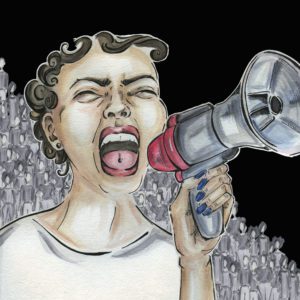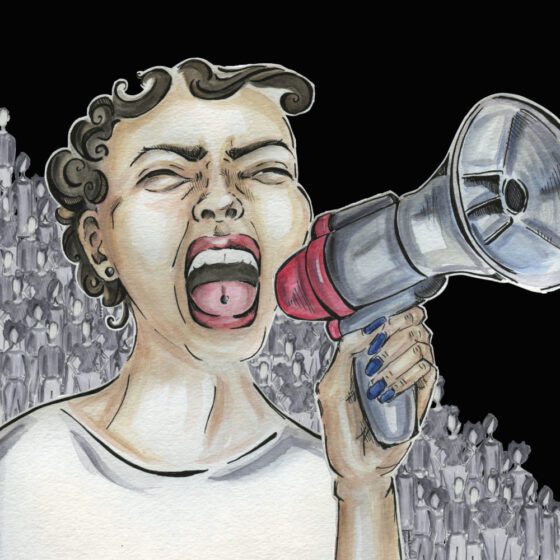
ENOUGH is a Rumpus series devoted to creating a dedicated space for essays, poetry, fiction, comics, and artwork by women and non-binary people that engage with rape culture, sexual assault, and domestic violence.
The series will run every Tuesday afternoon. Each week we will highlight different voices and stories.
***
The Scream
Natalie Hirt
I often wonder about that woman. Where she is now. Whether she’s okay. I want to know that she made her in way in this world in spite of what happened that night. I want to know if she has forgiven me, and all the others like me. I wish I could tell her I haven’t yet forgiven myself for not calling when she needed help. I let so much time go by between screams and still, I didn’t call.
Forgive me. Forgive me.
I was asleep on the couch after another fight with my husband. He was mean when he’d been drinking. I had just dozed off when I heard the first scream. A sound like someone had been surprised in an upstairs apartment. A woman. A scuffle. A lamp falling over. Did I really hear that? Or was it one of my nightmares?
I jumped up, ran into the bedroom. Shook him awake. “I heard a scream.”
He half-sat. We both listened in the dark. It felt like a long time though it was probably only a solid minute.
“No, no you didn’t,” he said. “I don’t hear anything.”
I went back to the couch still wondering if I’d really heard the scream. Just when I put my head down on the pillow, she screamed again. A bloodcurdling, horrifying, this-is-my-one-chance-please-help-me scream. I jumped up again. What to do? This was not my imagination. I’d heard that scream. Did I really need his permission to call the police? But, what if I was wrong and my brain was playing tricks on me? I ran back into the bedroom and shook him hard.
“Something bad is happening. I swear I heard a woman scream.”
He sighed and rolled away from me. “Leave me alone. I’m right here, and I didn’t hear nothin’.”
Back to the couch. I stood in front of it. I should call the police anyway. I could make the call. What was the worst thing that could happen?
I’d heard the woman. She’d screamed. I recognized that scream. I’d screamed that scream, and no one had helped me. She deserved better.
But what if this was just a fight with her boyfriend? I knew the routine. Cops would come and tell him to calm down. Be nicer. Then they’d leave. And I would be the one who…
Who what?
Interfered.
And if they came around here asking questions? My husband would have a fit. I’d be the one in trouble.
I paced with the phone in my hand. I paced in the dark. I paced back and forth in front of my baby daughter’s crib. Tears streaming down my face, I peered out the blinds. Told myself if I saw anything suspicious, any little thing, I would call. But the moon shone benevolent on the sidewalk. Palm trees swayed around the pool. There was no indication of anything gone wrong in the night.
And then, goddamnit, I heard something else. A not-quite-scream. A scream-sob. Whatever it was, it was over. And I never called.
I never called.
*
Spines
Laura Jensen
I saw her at a museum in Copenhagen, or I saw what was left of her: a pair of hip bones so thin I could have wrapped my hand from one edge to the other, accompanied by a spine that coiled around itself like the body of an upright snake, looping once at the fifth vertebra before continuing its awkward creep towards some kind of heaven. The spine, preserved since 1800, was illuminated in a display case alongside a series of early twentieth century public health notices that warned the Danish population of malnutrition. The spine was a before without an after, a body with no ghost.
Staring at the display case, I realized that the woman who once lived on these bones must have been small, almost childlike. I imagined that her features were soft, her blonde hair braided in a straight, thick line down her back as if to mock the uncertainty of the structure that lay beneath it.
The corresponding plaque said that the spine belonged to a woman who died of rickets, a disease that softens the bones due to lack of sufficient animal fat and sunlight. It didn’t say this, but she likely died, too, because what little food her family could find was given to every other mouth before her own; her skin was deprived of sunlight because her days were limited to the confines of a hearth.
In the end, the museum seemed to say, her spine was the thing that killed her, and the world knew only to look on. Whether they’d preserved it as a memory or a warning, I could not tell.
Twenty-four hours after seeing the body in the museum, I found myself sitting on the floor of the Copenhagen airport, waiting for a delayed flight back to London. I scrolled through my phone and stumbled across an article about how many women are killed in domestic violence disputes every year. It was Valentine’s Day. While some celebrated, others reminded us that love is so rarely what we need it to be.
Near the end of the article, the reporter interviewed a leader in domestic violence prevention research to understand why women so rarely leave their abusers, report their pain, say anything at all.
“Many women underestimate the risk that they are in, or put it in the back of their minds,” she said.
I wondered, as I watched passersby with their cups of coffee and cheap romance novels, if the woman who owned that spine had underestimated her risk, or whether her voice was louder than we’d like to admit. I imagined she waited until a doctor came to her home one day. She gently cited the way her back was beginning to curve, claimed her body could no longer bear the weight. I imagined her home: dark, but warm.
Call it historical memory or inherited trauma or anger, but I imagine that the doctor didn’t believe her; he thought she was just being hysterical. He told her to go about her usual duties, to please her husband, care for her children, pray for a better god. I imagined what it must have been like to slice open her body after she died. Someone must have taken a knife and made an incision into her spiraled self, found all-white bone staring back through blued blood and skin. Someone’s fingertips were first to touch the exposed vertebrae. Hold it for a moment. Believe it.
In October 2018, twenty-one-year-old Lauren McCluskey was murdered by her ex-boyfriend outside her dorm on the University of Utah campus. Three weeks earlier, Lauren reported her ex-boyfriend to campus police and asked for their protection. The university ignored her requests.
She was on the phone with her mother when she spotted him coming towards her. No, no, no, Lauren said, before dropping her phone to the pavement. As though she knew how bad it was. As though she knew what was coming, lifetimes before the bullet left his gun.
In the weeks after her death, I fall asleep with my hands in fists, my fingernails cutting deep into my palms. I open my hands each morning to find them full of crescent moons. I try to count out the differences between a display case and a casket. I come up empty.
I read that the university has since planted a tree in Lauren’s memory, a red maple. They say it will be beautiful to look at in the fall, when the leaves turn and decay. I wonder whose hands held the trunk as they dug the sapling’s roots deep into the earth. Whose fingers ran along Lauren’s spine before they lowered her body, inch by inch, into the frozen, autumn ground.
***
Rumpus original logo art by Luna Adler.
***
ENOUGH is a Rumpus original series devoted to creating a dedicated space for work by women and non-binary people that engages with rape culture, sexual assault, and domestic violence. We believe that while this subject matter is especially timely now, it is also timeless. We want to make sure that this conversation doesn’t stop—not until our laws and societal norms reflect real change. You can submit to ENOUGH here.
Many names appearing in these stories have been changed.
Visit the archives here.

